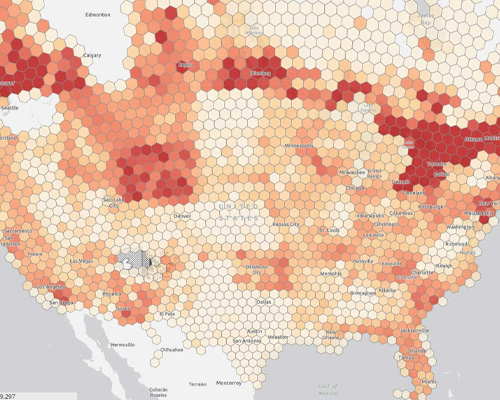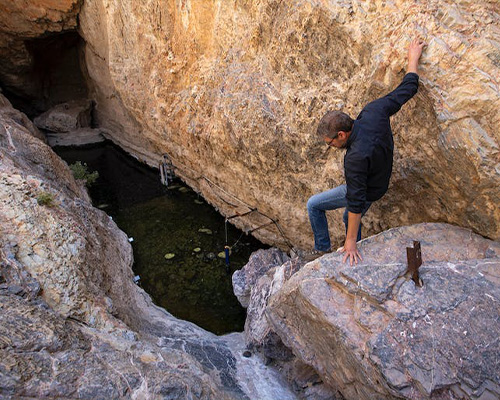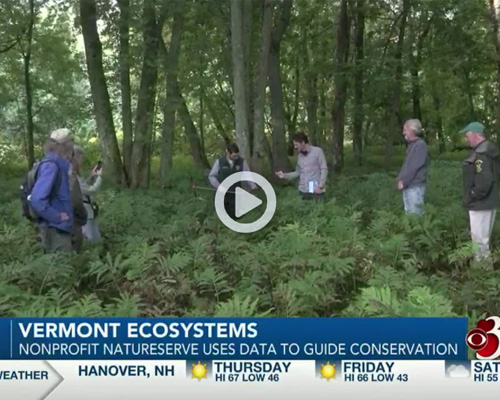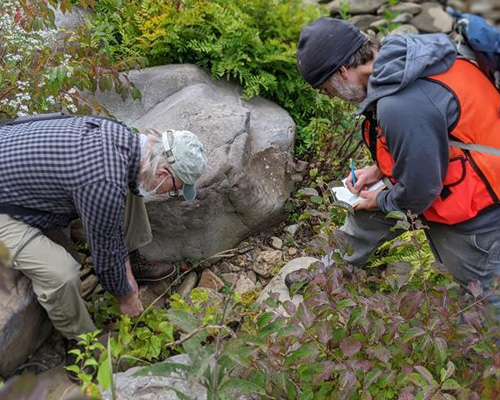See the curated media list below to learn more about NatureServe.
To speak with one of our experts—or for more information about what we do and how we work—please contact Samantha Belilty (954-655-2984).
Most Popular Media Hits

Exclusive: Huge chunk of plants, animals in U.S. at risk of extinction
FEBRUARY 6, 2023 | Reuters
A leading conservation research group found that 40% of animals and 34% of plants in the United States are at risk of extinction, while 41% of ecosystems are facing collapse. NatureServe said the report was its most comprehensive yet, synthesizing five decades' worth of its own information on the health of animals, plants and ecosystems.
Utah prairie dog (Cynomys parvidens) by James Marvin Phelps.

Extinction Crisis Puts 1 Million Species on the Brink
DECEMBER 23, 2022 | Reuters
"Knowing what we do about the impact of climate change and habitat loss, it's hard to imagine that thousands if not millions of species are not in the process of going extinct right now," said Sean O'Brien, an ecologist who heads the NatureServe nonprofit working to establish definitive data on North American species.

Trees Across the U.S. Face Dire Threats, New Report Shows
AUGUST 28, 2022 | PBS
A new report warns that at least 1 in 9 tree species in the U.S. are at risk of extinction. Trees face a host of threats including invasive species, deadly disease and climate change. The data comes as part of the most comprehensive threat assessment ever collected on U.S. forests. Host Geoff Bennett interviews the scientists involved in this study.
Why Trillium Have Become the Poster Child for Endangered Native Plants
MAY 25, 2022 | The New York Times
The plight of any native species is cause for concern, but with trillium there is another layer — almost an emotional factor. Their distinctive, early flowers charm us, making them a kind of poster plant for other species in trouble, ambassadors for an interest in growing and conserving natives.
A Fifth of World's Reptile Species Deemed Threatened With Extinction
APRIL 27, 2022 | Reuters
"This global assessment is a key beginning to understanding reptile conservation needs. Now we know where the priorities are and what the threats are that we need to ameliorate. There is no longer any excuse for leaving reptiles out of conservation planning and implementation efforts worldwide," said Bruce Young, co-leader of the study and chief zoologist and senior conservation scientist at NatureServe.

This Map Shows Where Biodiversity Is Most at Risk in America
MARCH 3, 2022 | The New York Times
To identify concentrations of imperiled biodiversity, scientists created models for more than 2,200 species based on where they are known to exist and their habitat needs. The research and the related maps were a partnership between NatureServe and its network of state partners, Esri, and the Nature Conservancy.
Media Hits Continued
Oregon Department of Fish and Wildlife’s List of Species at Risk Surpasses 300
AUGUST 29, 2025 | Oregon Capital Chronicle
Oregon’s updated State Wildlife Action Plan now lists more than 320 at-risk species, with a NatureServe report ranking the state fifth in the nation for imperiled wildlife.
From Classroom to Creek: East Texas A&M Students Study Elusive Painted Crayfish
AUGUST 27, 2025 | NewsBreak
East Texas A&M students are studying the rare Kisatchie painted crayfish, a species ranked globally imperiled (G2) by NatureServe, to better understand its decline and guide conservation efforts.
How Close Are Manatees to Extinction?
AUGUST 25, 2025 | The Atlantic
Scientists used data from NatureServe to show that weakening habitat protections under the Endangered Species Act could drive at least 49 already vulnerable species—including manatees—closer to extinction.
Scrambling After Finding Endangered Leafy Prairie Clover on Langham Island
JULY 27, 2025 | Chicago Sun Times
A volunteer’s rediscovery of the endangered leafy prairie clover on Langham Island highlights its rarity, with NatureServe ranking the species as globally imperiled (G2).
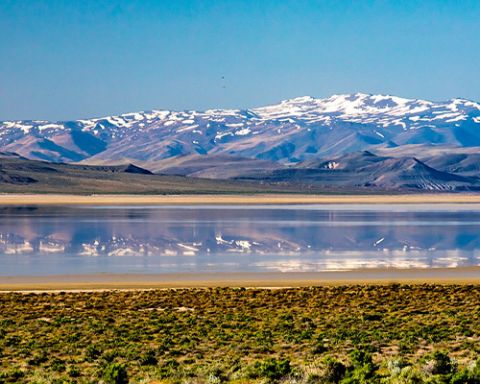
Nevada Ranks 11th in Biodiversity, Third for At-Risk Species: What to Know
FEBRUARY 26, 2025 | Reno Gazette Journal
Nevada is the 11th most biodiverse state in the nation but ranks third for having the most plants and animals at risk, according to NatureServe, a nonprofit that provides conservancy data to public and private entities.

Flightless Species Suspected of Being Extinct Rediscovered in Virginia 80 Years Later
FEBRUARY 13, 2025 | Miami Herald
In 2007, one scientist wrote on NatureServe, “Probably no living person has any field experience with this species. For now it is assumed that if it still does exist it probably occurs in large mountain pitch pine-scrub oak barrens.”

New Mexico Rare Arthropod Resource Website Launches to Help Conserve Arthropod Species
JANUARY 29, 2025 | Phys.org
Included on the site are New Mexico arthropods that are rare, endemic, or threatened. Threatened status is evaluated either by IUCN Red List of Threatened Species or NatureServe conservation assessments.

Streamlining Access to Biodiversity Data in North America
WINTER 2025 | ArcNews
NatureServe Explorer Pro provides secure, real-time access to species data across North America. Built with ArcGIS technology, the app supports industries like forestry and agriculture with interactive tools and AI-powered habitat models, all while protecting sensitive species information.
How Companies Monitor Biodiversity: Behind the Development of a New Tool
DECEMBER 3, 2024 | WhereNext
Behind the seamless rollout of every software product, there’s a story of ingenuity, hidden hurdles, and digital MacGyvering. Such is the saga of NatureServe Explorer Pro, the groundbreaking biodiversity tool from North America’s leading biodiversity information provider, NatureServe.
Western Monarch Butterflies Favor Private Land. Now What?
NOVEMBER 25, 2024 | HighCountry News
A new analysis by NatureServe scientists models the monarch butterfly's migration routes and demonstrates the need for a collaborative conservation approach between public and private lands.

Ramboll Launches First-Of-Its-Kind Global Biodiversity Metric at COP16 to Help Restore Nature
OCTOBER 28, 2024 | AP News
Ramboll, a global engineering, architecture and consulting firm, launched a first-of-its-kind global metric for measuring the biodiversity value of habitats on sites around the world. Their approach leverages NatureServe's Ecological Integrity Assessment protocol for evaluating and managing biodiversity.

A Herpetologist Reveals America’s 3 Rarest Snakes—And Where To Find Them
JULY 21, 2024 | Forbes
A study co-led by NatureServe’s Bruce Young reveals that 20% of reptile species are threatened with extinction. This article highlights three of the rarest snake species in North America, emphasizing the need for targeted action to protect these vulnerable reptiles.
Data Firm Launches Tool to Drive Conservation Efforts in U.S.
JULY 10, 2024 | Carbon Pulse
NatureServe has launched an enhanced conservation data platform for the Western U.S., using an updated Map of Biodiversity Importance. This tool aids conservation efforts by providing detailed insights into critical habitats, including new biodiversity hotspots.
IUCN Adds 1,000 Species to Extinction Endangered List
JUNE 8, 2024 | The Wildlife Society
The IUCN has added 1,000 species to its Red List of Threatened Species, bringing the total to over 45,300. Anne Bowser, CEO of NatureServe, underscores the critical role of scientific assessment in guiding conservation actions.

A Win for Growers Who Protect Biodiversity on Agricultural Land
JUNE 6, 2024 | Modern Farmer
Farmers are increasingly using biodiversity mapping to identify and protect endangered species on agricultural lands. NatureServe's Vice-President of Conservation, Regan Smyth, highlights the importance of collaboration with landowners in these efforts.

A Tale of Two Frogs: The Tough Uphill Battle for Rediscovered Species
JUNE 4, 2024 | Mongabay
NatureServe Chief Botanist Wes Knapp is quoted in this article about the dire status of at-risk species in the United States, saying “I really wish there was a process … where they preemptively petition all these ‘extinct’ plants so if they’re rediscovered, they’re automatically protected.”
Should the Hawthorn Be Saved?
MAY 13, 2024 | The Atlantic
In this article that examines the curious case of hawthorn trees, Chief Botanist Wes Knapp is quoted as saying, “If we just dismiss these things as doomed, then we’re probably not going to conserve them.”
Queen Snakes Are Back, and They’re in New Jersey
APRIL 30, 2024 | The New York Times
Scientists uncovered the first queen snake known to have been in seen in New Jersey since 1977. The species is endangered in New York and listed as critically imperiled by NatureServe.

Restoring Woodpeckers and Pines to Big Thicket
APRIL 1, 2024 | National Parks Conservation Association
The National Parks Conservation Association partnered with NatureServe to produce data that shows the most suitable habitat in and around Big Thicket for woodpecker and pine restoration.

Invasive Dupes, Part 5: The Common Reed’s Identity Crisis is a Doozy
MARCH 1, 2024 | WWTW News
In honor of National Invasive Species Awareness Week, WWTW identifies "dupes"—invasive species that can be easily confused with native ones. According to NatureServe's report, invasive species are among the top drivers of loss for plants and animals in the United States.
After 50 Years of the U.S. Endangered Species Act, We Need New Biodiversity Protection Laws
FEBRUARY 16, 2024 | Mongabay
"As we welcome 2024 and celebrate the strides made in biodiversity legislation, let's draw inspiration to forge even more robust laws this new year," Sean O'Brien, President & CEO of NatureServe, argues in this op-ed. "In the face of the urgent biodiversity crisis, our new legislation must match the immediacy of this threat."
We Deserve a Knuckle Dagwood
DECEMBER 22, 2023 | The Washington Post
In a letter to the editor of the Washington Post, NatureServe President & CEO Sean O'Brien addresses the importance and relevance of the Endangered Species Act, which was the subject of a misinformed joke in the comic Blondie.

The Ridiculously Stupid Reason the US Is Letting Animals Spiral Toward Oblivion
DECEMBER 18, 2023 | Vox
Among the most comprehensive environmental laws worldwide, the Endangered Species Act (ESA) was set up to protect the nation’s many plants and animals that are at risk of extinction. As the ESA heads into its next era—a period that will bring profound environmental change—its ability to stem the extinction crisis warrants a closer look.

Top 55 Non-profit Organizations Fighting for the Environment With Technology
NOVEMBER 17, 2023 | Omdena
The Omdena “Impact Changemakers Series” comprises game-changing civil society organizations, stories, and thought-leadership pieces from leading organizations that make an impact on solving real-world problems.

Nearly Half of Flowering Plant Species Face Threat of Extinction
OCTOBER 10, 2023 | Common Dreams
Scientists globally caution that 45% of known flowering plant species may vanish. This adds to recent alarming reports, such as NatureServe's findings that 34% of U.S. plant species and 40% of animal species face extinction, with 41% of U.S. ecosystems in danger of collapse.

Utah Prairie Dog Flourishing Again, Thanks to a Little Help From Its Human Friends
AUGUST 26, 2023 | Desert News
The Utah prairie dog was once on its way to extinction; now, thanks to the watchful eye of the Utah Division of Wildlife Resources, the species is flourishing

Back from the Dead: New Hope for Resurrecting Extinct Plants
JULY 12, 2023 | Yale Environment 360
Armed with new technology, botanists are proposing what was once thought impractical: reviving long-lost plant species by using seeds from dried specimens in collections. The challenges remain daunting, but researchers are now searching for the best de-extinction candidates.

California Assembly Passes Landscaping Bill to Support Biodiversity and Water Conservation
JUNE 21, 2023 | The San Fernando Valley Sun
The California State Assembly has passed a new bill that requires the use of native plants in commercial and public landscaping projects. The new legislation is a critical step in preserving biodiversity in urban environments.

A Plant Smaller Than a Penny Is Rediscovered on a Lopoc Military Base. Here’s Why We Should Care
MAY 22, 2023 | Los Angeles Times
Roughly 34% of plants in the United States are at risk of extinction due to habitat destruction, climate change or invasive species, according to a February report from NatureServe, a nonprofit conservation group.

Birth of Wild Red Wolf Pups Brings Hope to Species on Brink of Extinction
MAY 19, 2023 | LiveScience
Red wolves are not the only U.S. species struggling to survive in a rapidly changing world. In February, NatureServe, a conservation group focused on biodiversity in North America, released a report that revealed up to 40% of animal species and 34% of plant species are at risk of going extinct in the country.

Bats Play Key Role in Staten Island’s Ecosystem. Half of Species in U.S. At Risk, Researchers Say
APRIL 18, 2023 | Staten Island Live
100 scientists from the U.S., Canada and Mexico virtually convened to contribute to a report on the conservation status of bats species in North America. Using NatureServe's conservation status assessment, the researchers found that around half of the bat species are at risk of severe population decline in the next 15 years.

Hundreds of WA Plants, Animals at Risk of Extinction
February 26, 2023 | The Seattle Times
In a newly released report, conservation research group NatureServe analyzed data from its network of more than 1,000 scientists across the United States and Canada. The group said the report is its most comprehensive yet, synthesizing more than 50 years of biodiversity information and highlighting the urgency of biodiversity conservation.

More Than One-third of Animals, Plants at Risk of Extinction in US: Report
FEBRUARY 6, 2023 | The Hill
NatureServe's analysis, based on 50 years of data, determined that 34 percent of plants and 40 percent of animals are threatened, with wide variations for particular species and by region.

Monitoring the Health of North America’s Ecosystems
JANUARY 2023 | ArcWatch
This Arcwatch blog from Esri illustrates how NatureServe used ArcGIS Pro, in combination with other GIS software, to implement the Red List of Ecosystems to North America and assess ecosystems' risk of collapse.
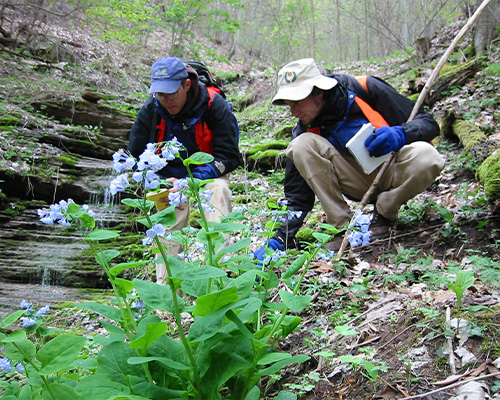
Five Good Questions: Lori Scott, NatureServe
JANUARY 27, 2023 | Inside Unmanned Systems
Lori Scott, Chief Information Officer and VP for Technology & Partnerships at NatureServe, is asked five questions hitting at what NatureServe does, what makes our data unique, and how technology is changing the way we work.

When an Extinct Species Is Found Alive, What Happens Next?
NOVEMBER 1, 2022 | The Scientist
Finding a creature in the wild that had been considered long gone brings hope—and quite a bit of uncertainty. NatureServe Cheif Botanist Wes Knapp shares the complicated questions he and colleagues had to answer after rediscovering a lateleaf oak, which was thought to have been lost in 2011.
In this episode of Environmental Professionals Radio, hosts Laura Thorne and Nic Frederick speak with NatureServe Chief Botanist Wes Knapp about the work NatureServe does, extinct plants, and stories from the field.
The Curious Case of the Missing Extinctions
OCTOBER 13, 2022 | Outside/In Radio
NatureServe's Sean O'Brien and Wes Knapp guest star in this episode of Outside/In to help answer why it's so difficult to officially declare an animal extinct. Along the way, producer Taylor Quimby compares rare animals to missing socks, finds a way to invoke Lizzo during an investigation of an endangered species of crabgrass, and learns about the disturbing concept of “dark extinctions."

Up to 135 U.S. Tree Species Face Extinction—and Just Eight Enjoy Federal Protection
AUGUST 24, 2022 | Science
Researchers evaluated how endangered each tree is according to criteria developed by the organizations NatureServe and the International Union for Conservation of Nature (IUCN). As a result of invasive insects, pathogens, climate change, development, and other threats, the team found, 11% to 16% of those trees—as many as 135 species—face possible extinction.

Monarch Butterflies Added To Endangered List
JULY 21, 2022 | Forbes
“Few species evoke the awe and wonder that the migratory monarch butterfly commands,” NatureServe CEO & President Sean O’Brien said in a statement with the IUCN. “While efforts to protect this species are encouraging, much is still needed to ensure its long-term survival.”
"The majority of species on the planet are plants and insects and other invertebrate animals that we know so little about we cannot even determine the extent to which they are threatened," said Healy Hamilton, Chief Scientist at NatureServe. "And yet those are the very species which help purify our air, filter our water, maintain the health of our soils, pollinate plants we need for food, fuel and fiber, and provide medicines to hundreds of millions of people."
Scientists Rush to Save 1,000-Year-Old Trees on the Brink of Death
JULY 15, 2022 | The Washington Post
“We have a second chance to prevent a species extinction,” said Wes Knapp, the chief botanist for the conservation nonprofit NatureServe and a member of the expedition to find the vulnerable bristlecone pine. “That’s really rare, to have a second chance in nature. It means we can move. We can act. That’s what we have to do now.”

Celebrate America With Photos of Our Unique Species
July 1, 2022 | National Geographic
To date, scientists have identified more than 32,000 distinct animal species living in the country. According to NatureServe, an organization that keeps tabs on North American flora and fauna, more than 7,000 of those species are endemic, meaning they’re native to the U.S. and nowhere else—and researchers are certain that’s an underestimate.

Taking Stock of Native Plants, With NatureServe’s Wesley Knapp
JUNE 12, 2022 | A Way to Garden
Do we know what species are already gone–from the small tree that gardeners covet that is extinct in the wild called Franklinia, to various others that are less well-known. And how do we know where to focus our conservation efforts? Listen to this podcast episode, featuring Wes Knapp, Chief Botanist at NatureServe.

Why Large Numbers of Reptile Species Face Extinction
APRIL 27, 2022 | PBS
Globally, about 20 percent of reptile species are facing the threat of extinction. That's according to a recent study in the scientific journal "Nature." Geoff Bennett takes a deeper look now at what’s driving this extinction crisis and what it could mean for the rest of the world.

Groundbreaking Study Reveals the Most Threatened Reptile Species
APRIL 27, 2022 | CNN
"Reptiles, to many people, are not charismatic, and there's just been a lot more focus on the furry or feathery species of vertebrates for conservation. But through persistence we were able to find the funding needed to complete the study," Bruce Young, chief zoologist and senior conservation scientist at NatureServe and one of the authors of the study.

From King Cobras to Geckos, 20 Percent of Reptiles Risk Extinction
APRIL 27, 2022 | The New York Times
About 20 percent of reptile species risk extinction, mainly because people are taking away their habitats for agriculture, urban development and logging, according to the first global reptile assessment of its kind. “It’s another drumbeat on the path to ecological catastrophe,” said Bruce Young, co-leader of the study and a senior scientist at NatureServe.

One-fifth of Reptiles Worldwide Face Risk of Extinction
APRIL 27, 2022 | AP News
Worldwide, the greatest threat to reptile life is habitat destruction. Hunting, invasive species and climate change also pose threats, said co-author Neil Cox, a manager at the International Union for the Conservation of Nature’s biodiversity assessment unit. Six of the world’s species of sea turtles are threatened. The seventh is likely also in trouble, but scientists lack data to make a classification.

Here’s Where Biodiversity is Disappearing the Quickest in the US
MARCH 14, 2022 | Popular Science
“When we think of biodiversity, we may reflect on tropical rainforests or coral reefs, where the richness of life is indeed staggering,” author Healy Hamilton, chief scientist at nonprofit NatureServe said in a release, “but our own country harbors globally significant biodiversity. The findings from the Map of Biodiversity Importance show us areas critical for preventing extinction across the nation.”
A Bright Spot on a Bleak Map
MARCH 8, 2022 | Adirondack Explorer
The color scale on the map ranges from dark green to blood red based on how much biodiversity has declined in the continental United States, showing areas of risk for plants and animals threatened with extinction. In the Northeast, the Adirondacks offer refuge to eyes combing the map, with its pop of bright green in the troubling vastness of red.
In the 1990s, the Ecological Society of America (ESA), NatureServe, and federal land management agencies came together to address a significant need: the creation of a systematic vegetation classification system for the US. Its use and implementation by various groups helps to foster interagency collaboration and consistent reporting on the nation’s vegetation resources.

Global Conservation Goals Are Insufficient to Avoid Mass Extinction
JANUARY 19, 2022 | The Globe and Mail
“You can have a situation where a country like Canada feasibly meets all of its targets by 2030 … where we do all the right things within our borders, but still, through our trade and consumption patterns, drive massive biodiversity loss in tropical areas,” NatureServe's Mike Gill provides insight on a new report on biodiversity goals.
Biodiversity Matters to Everyone, So Let’s Protect It
FALL 2021 | ArcNews
It is essential that we all care about biodiversity. As Dr. Healy Hamilton, chief scientist of NatureServe, pointed out in her Keynote Address during the Esri Science Symposium at this year’s Esri User Conference, diversity of life is the foundation of our ecological, cultural, economic, and spiritual well-being.
Conservation Group Visits Vt. on Biodiversity ‘expedition’
OCTOBER 6, 2021 | WCAX
NatureServe CEO Sean O’Brien visits with Fish & Wildlife Department staff in Colchester as the 17th stop of the NatureServe Network Van Tour to understand how Vermont is protecting its wildlife and what threats they face in doing so. Watch the video to see some of the highlights.
1 In 3 Tree Species Face Extinction
SEPTEMBER 10, 2021 | Eurasia Review
One in three trees worldwide are facing extinction, with human use among the greatest threats, according to the first State of the World’s Trees report published by Botanic Gardens Conservation International (BGCI).
New Maps Show U.S. Rivers With High Natural Values
AUGUST 23, 2021 | Pew Charitable Trusts
To help policymakers, elected officials, and other stakeholders in the U.S. make better-informed decisions, The Pew Charitable Trusts engaged NatureServe and Michigan State University to build national databases of watershed conditions and barriers that alter the natural flow of freshwater bodies.
Join us in the Cedar Glades State Natural Area for a VIP Tour
JULY 27, 2021 | Tennessee's WildSide
Scientists who specialize in the study of plants and animals find plenty of places in Tennessee to do their research. The unusual plants you can find in the Cedar Glades remind all of us how important it is to protect and preserve our natural resources.
'Big data' helps direct preservation decisions
MAY 21, 2021 | Bay Journal
Synthesizing huge amounts of biodiversity data — NatureServe scientists processed nearly 100 million data exchanges in 2020 alone — allows decision makers to determine which places are most in need of saving, even if they don’t have an iconic species steering the way toward preservation.
Working Together to Save Plants
APRIL 29, 2021 | AP News
A new partnership between the United States Botanic Garden (USBG) and NatureServe unites expertise in plant conservation and education. Together, the partners will tackle two critical areas of plant conservation while also educating the public about the growing risk of plant extinction.
In a study published in Conservation Biology, NatureServe Chief Botanist Wes Knapp and 15 other researchers from across the United States quantified how many trees, shrubs, herbs and flowering plants have vanished from North America since European settlement. After compiling existing information on presumed extinct species and working with local botanists to vet the data, the group narrowed down a list of 65 plant species, subspecies and varieties that have been lost forever in the wild.






